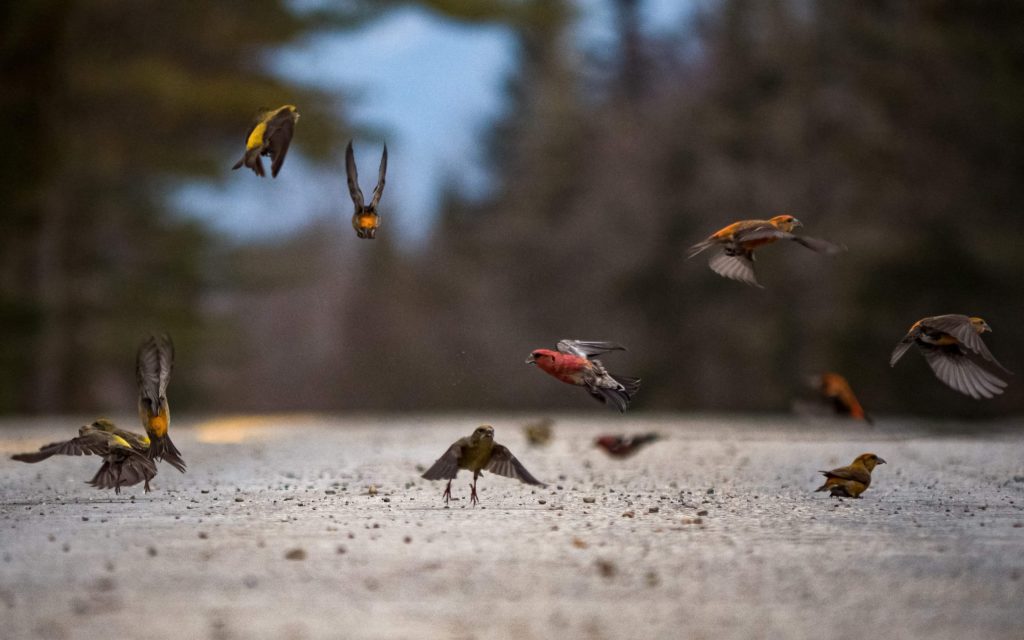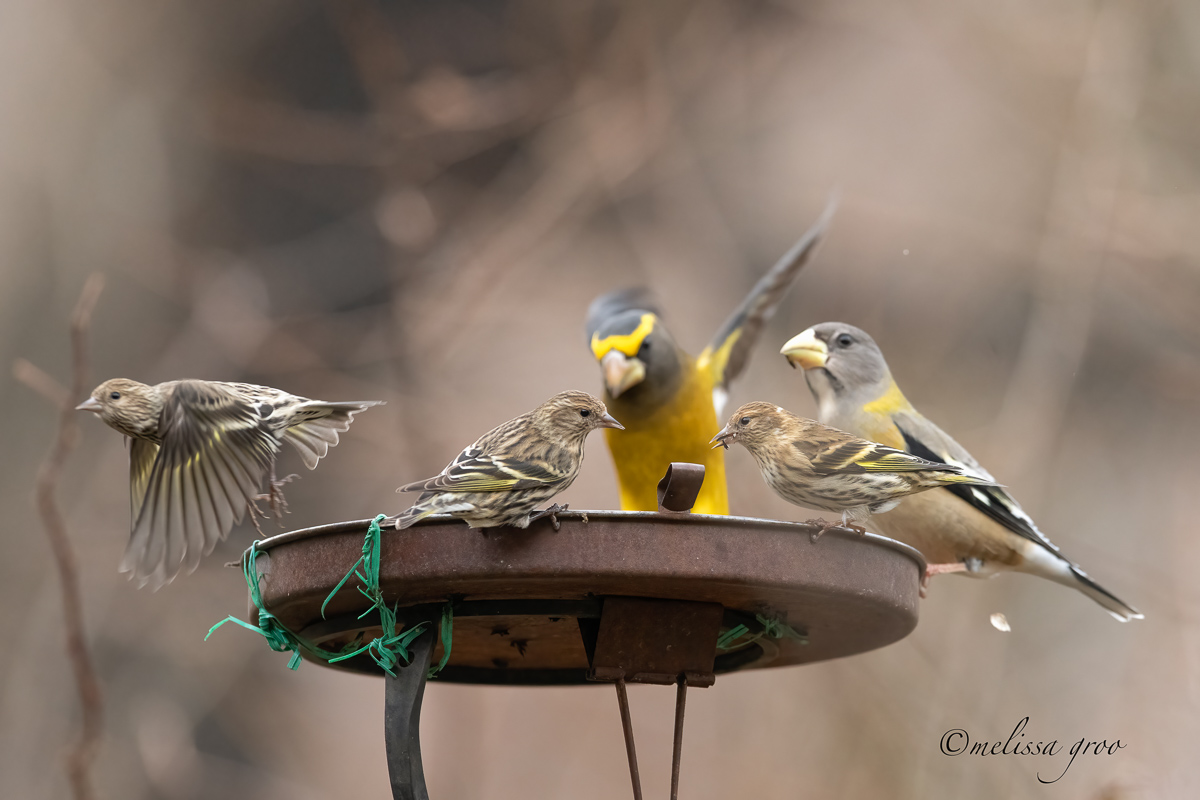Finch Food Assessment, Become a Finch Forecaster
By Matthew Young, Ryan Mandelbaum, Ken McEaney, and Tyler Hoar:
Interested in becoming a Winter Finch Forecaster? We have started an iNaturalist project to supplement the form that Tyler Hoar, finch forecaster extraordinaire, sends to volunteers each summer. Now, you can be a part of the Winter Finch Forecast team and help provide cone crop information. Click here to learn more.
We are only looking for photos and qualitative data: a ranking of food crops on a scale of 0-11: None (0), to Very Poor(1-2), Poor(3-4), Average/Fair (5-6), Good (7-8), Excellent (9-10), and Bumper(11). Just click “Add An Observation,” upload your photo, enter ID for tree species if you know it, and then select the option that best describes your assessment.
For conifer species other than hard-coned pines (like red, jack, and pitch pine), rank the food crop based on the four quadrants in the upper half of the tree. For an Excellent crop, the branches will look covered with cones and berries and weighed or bent down. During such years the food crop will extend to the lower two quadrants. For “bumper” crops, there are so many cones/berries it looks like the branches could snap under their weight.
We understand that what an observer thinks is average varies between each observer, so just go with your gut. We are using all information to paint the big picture of what we can hopefully look forward to each fall and winter. To start, this project will help predict the movements of Red Crossbill, White-winged Crossbill, Evening Grosbeak, Pine Grosbeak, Redpolls and Pine Siskin.
For guidance on the conifers of the eastern forest, please see the following article on the Finch Research Network website: https://finchnetwork.org/a-crossbills-guide-to-conifers-of-the-northeastern-forest
Some tips and tricks to keep in mind as we continue to refine the methods to becoming part of the Finch Forecasting team are:
- Have fun, and don’t get too caught up in counting the specific number of cones/fruit. Again, we are looking for qualitative ranking data. The more we collect, the more powerful and accurate the data will be.
- Take lots and lots of photos. When taking photos of the fruit/cone/seed crop, analyze the area holistically. Be sure not to just take photos or rank the trees that have food—it’s important to also look at and take photos of a few trees that represent the food crop in the area. With that, negative data (trees with no food) also carries value.
- Treat each species separately. Don’t compare fruit on a mountain ash to a samara seed crop on a maple species. Don’t compare a cone crop on a hemlock (tiny cones), to cones found on a white pine (very large) or red pine (can come in several ages). Try to get some close ups of cones or fruit as well, especially where the cones or fruit are small like with hemlocks and tamaracks. For white pines, Norway spruce, firs and native spruces, cell phone photos often will do, but for hemlocks and larches (tamarack) a camera is helpful!
- When you’re observing hard pines (red, pitch, jack, Japanese black, loblolly etc.), be sure to take pictures of the cones so you can get a good handle on the ages of cones and what cones might have seed. For these hard-coned pines, we rate cones that are new (reddish) and closed, new and open (still reddish), old and closed (brown), and old and open separately. You can also have green cones (that will ripen several months later in late winter/spring, darker brown cones (seen 1-2 years after the cone developed), to even grayish-brown cones (they are old and might very well not have any viable or reachable seed). Rate the current crop based on lighter to darker brown cones.
- Take photos and more photos and upload with your assessment to iNaturalist here: https://www.inaturalist.org/projects/finch-forecast-food-assessment Here are the rankings again of food crops on a scale of 0-11: None (0), to Very Poor(1-2), Poor(3-4), Average/Fair (5-6), Good (7-8), Excellent (9-10), and Bumper(11). Just click “Add An Observation,” upload your photo, enter ID for tree species if you know it, and then select the option that best describes your assessment. In the comments section of the report in the iNaturalist project, please do add comments about the overall food crop.
- If you see a crossbill, redpoll or grosbeak foraging (or any of the finches listed in this article), please also enter the finch species into this iNaturalist project. Then, feel free add it to the Crossbill or Evening Grosbeak foraging iNaturalist’s Finch Research Network projects as well if you have the time. We know everyone is busy, so any contributions are appreciated. See below for links.

A spruce tree with a good (an 8 or so) cone crop. Image credit: Ryan F. Mandelbaum
While these projects have been ongoing for several months, we’d like to engage more people and show them the fun of keeping track of our finches and their food sources. The more photos, the better the data set will become over time. We hope that combined with our other projects, we’ll soon have a nice visual guide for each of the 15-20 tree species that boreal finches love as well.

For more information on related North American Red Crossbill and Evening Grosbeak Foraging iNaturalist’s Projects click below (stay tuned for more about these projects):
https://www.inaturalist.org/projects/red-crossbill-foraging-in-north-america
https://www.inaturalist.org/projects/evening-grosbeak-foraging
Again, for guidance see “A Crossbill’s Guide to Conifers of the Eastern Forest” article on the Finch Research Network website: https://finchnetwork.org/a-crossbills-guide-to-conifers-of-the-northeastern-forest
Our focus will be on Red Crossbill, White-winged Crossbill, Evening Grosbeak, Pine Grosbeak, Redpolls and Pine Siskin. Trees to monitor for food assessments and finch feeding, in no particular order of importance are:
White Spruce
Black Spruce
Red Spruce
Other Spruce species (Engelmann, Norway, Blue)
Tamarack
Eastern Hemlock
Eastern White Pine
Red Pine
Jack Pine
Other Pine Species (Pitch, Japanese Black Pine etc)
Northern White Cedar
Paper (aka White) Birch
Yellow Birch
Other Birches (Bog, Gray, Black)
Alder Species (Speckled, Red,Black)
Sugar Maple
Box Elder
Other Maples (Red, Black)
White Ash
Other Ashes (Black, Green)
Mountain-ash
Winterberry
Cover Photo Melissa Groo
The originator of the Winter Finch Forecast, Ron Pittaway, recently passed away, and we are all greatly saddened by this. The above project has been in the works for many months, and hopefully it would have made him proud. To read a beautiful tribute to Ron by the new winter finch forecaster and Finch Research Network Board Member Tyler Hoar, click here: https://finchnetwork.org/a-passing-of-a-legend
Godspeed Ron!
FiRN is a nonprofit, and was been granted 501c3 status in 2020. We are a co-lead on the Evening Grosbeak Road to Recovery Project, and have funded upwards of $10,000 to go towards research, conservation and education for finch projects in the last year plus. FiRN is committed to researching and protecting these birds and other threatened finch species like the Evening Grosbeak, Rosy-finches, and Hawaii’s finches the honeycreepers, and if you have been enjoying all the blogs and identifying of Evening Grosbeak and Red Crossbill call types (upwards of 15,000 recordings listened to), redpoll subspecies and green morph Pine Siskins FiRN has helped with over the years, please think about supporting our efforts and making a small donation at the donate link below.

